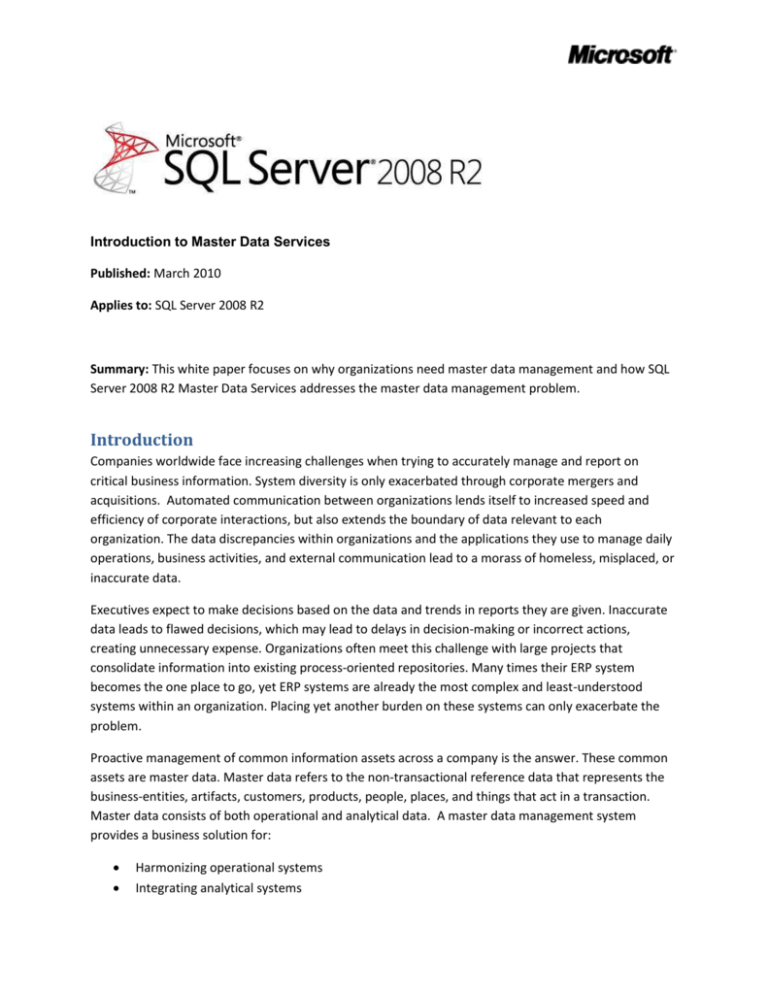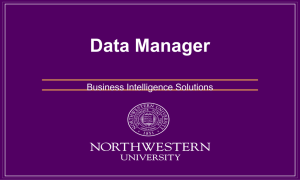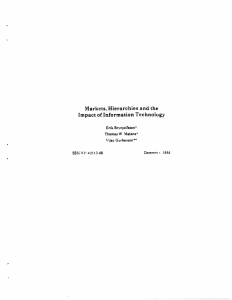Introduction to Master Data Services
advertisement

Introduction to Master Data Services Published: March 2010 Applies to: SQL Server 2008 R2 Summary: This white paper focuses on why organizations need master data management and how SQL Server 2008 R2 Master Data Services addresses the master data management problem. Introduction Companies worldwide face increasing challenges when trying to accurately manage and report on critical business information. System diversity is only exacerbated through corporate mergers and acquisitions. Automated communication between organizations lends itself to increased speed and efficiency of corporate interactions, but also extends the boundary of data relevant to each organization. The data discrepancies within organizations and the applications they use to manage daily operations, business activities, and external communication lead to a morass of homeless, misplaced, or inaccurate data. Executives expect to make decisions based on the data and trends in reports they are given. Inaccurate data leads to flawed decisions, which may lead to delays in decision-making or incorrect actions, creating unnecessary expense. Organizations often meet this challenge with large projects that consolidate information into existing process-oriented repositories. Many times their ERP system becomes the one place to go, yet ERP systems are already the most complex and least-understood systems within an organization. Placing yet another burden on these systems can only exacerbate the problem. Proactive management of common information assets across a company is the answer. These common assets are master data. Master data refers to the non-transactional reference data that represents the business-entities, artifacts, customers, products, people, places, and things that act in a transaction. Master data consists of both operational and analytical data. A master data management system provides a business solution for: Harmonizing operational systems Integrating analytical systems Supporting compliance (i.e., Sarbanes-Oxley) Enabling an auditable, repeatable business process Capturing and protecting human intelligence about hierarchical structures that would otherwise be homeless data Organizations waste considerable time and money figuring out who has the right view of their internal world. They expend more time and money attempting to apply management's preferred view across the many different systems used in a company, and repairing mistakes that sneak into reports. They either spend money fixing the problems before they occur or they pay the higher cost of fixing the problems as they manifest themselves in downstream decisions or public reports. They may use the IT department as a problem-solver, attempting to fix business problems by using technical solutions. The Strategic Costs of Keeping the Status Quo The cost of not undertaking master data management can be significant: Mistaken understanding of which products are profitable and growing. Mistaken belief that reports are accurate, leading to incorrect decisions, such as closure of the wrong retail branches or funding of the wrong products. Misalignment of management reports versus statutory reports. A systemic inability to track a particular attribute or activity at a granular level or, conversely, at the enterprise-wide level, leading to the creation of homeless data stores that lack visibility across the enterprise. Vulnerability to security and data integrity problems that arise from the lack of a defined process to control important aspects of the analytic tools used in the enterprise. Lack of agility within business processes, leading to missed opportunities. The Problem for IT The IT department must empower the business user to own their data while simultaneously managing the data constraints of the business. Allowing the business decision makers to modify the data directly provides the flexibility and speed with which business must adapt to the changing markets. Unfortunately the need for this data to be applied across so many different systems requires IT involvement. Data changes must be closely managed in order to meet the technical needs of all applications while providing proper access to all business users. Without IT-managed systems that maintain all attributes of master data, business users search for ways to solve their business problems, thereby creating ad-hoc systems that promote isolated solutions and contributing to homeless data that is important to the business. Once business users have effectively solved business problems for themselves, it is difficult for the IT department to regain control of the rogue system from ownership by the business user. These proliferating systems mean many stakeholders are solving the same problems and have little ability to share the solution. 2 One way to size up the master data management issue at your organization is to gauge it by factors of complexity and rates of change. The complexity factors include: The number of separate transactional, operational, and analytic systems your company uses. How many charts of accounts or organizational hierarchies are required to manage your business operations. The rates of change include the rate of: Organizational changes. Growth of the business. Customer or employee churn. Product development life cycle. If the complexity and rate of change go up at a linear rate, it tends to complicate the master data management problem at a geometric rate. Most companies have nearly ten different business applications running, meaning there are potentially 45 different point-to-point interfaces to manage. The Master Data Services solution Master Data Services: Brings the management of master data to the data stewards who use the data as part of daily operations for the organization. Provides a platform with which to build multiple master data applications across the organization to manage all domains within a common data framework. Allows the organization to leverage its existing data transformation applications. Master Data Services provides the following features. Flexible Modeling Traditional ERP systems are generally used to store targeted selections of attributes. Custom fields can extend the number of attributes stored but can end up being used in a way that wasn’t originally intended. No single process-oriented system is in the position to be this superset of all domain attributes. Providing a single system to model the entire master data domain can be a useful tool to ensure business owners effectively track all known attributes across the enterprise. Master Data Services provides a flexible modeling environment allowing you to manage the superset of all attributes across all systems for a given domain. There is no pre-defined structure for entering product or customers, although industry-standard models can be loaded using the model deployment feature and can be further customized after loading. 3 Ubiquitous Access to Master Data A master data management project brings together users of disparate roles, for example salespeople and foremen. It is impractical to provide a single interface that every business user can interact with while performing their day-to-day tasks. Master Data Services provides a Web application that acts as a portal to enable users to interact with master data without requiring the installation of a thick client application on their desktops. This provides ease of system management, as well as ubiquitous access across the corporate intranet. Master Data Services also provides a Web service to enable entrenched applications to be retro-fitted to update master data in real time without additional training costs or process changes. Any person or system with the proper authority can contribute or subscribe. Versioning Organizations have many different views of particular data, whether it’s based on periods of time or different organizational changes that occur. The inability to manage these facets of the domain is a key deficiency in most business process systems. To gauge the effects of major changes to the business environment before updating core systems, organizations need to temporarily manage alternate versions of the master data. Master Data Services provides the ability to version each model at different intervals, such as monthly, quarterly, or at any other interval that the business requires. Within Master Data Services, users can work on open versions of models that align to alternate business scenarios while models are simultaneously versioned at the intervals required by the business. Master Data Services also provides the ability to tag versions for use by subscribing systems. These tags allow integration processes to remain constant while managing the version lifecycle within Master Data Services. Hierarchies Hierarchies can provide organizations with analytical consolidations as well as categorizations to enhance business owners’ understanding of the interaction among master data elements. As a business grows in complexity, the number of relevant hierarchies that need to be managed can increase considerably. Very few business applications provide effective hierarchy management capabilities, which leads to many hierarchies being managed in home-grown applications or in Excel spreadsheets. Another problem that exists within enterprises is the need to manage multiple hierarchies that share structure at the highest levels but diverge at lower levels based on differences in business units. This can lead to maintenance problems as the top levels must be maintained consistently across multiple hierarchies, where no tools exist to manage this problem. Master Data Services provides a wealth of options for managing hierarchies. Explicit hierarchies can be created based on traditional parent-child relationships. Derived hierarchies can be created from pre- 4 existing data relationships found within a Master Data Services model. For instance, the relationship of zip code to county, state, and country can be used to create a leveled geographic hierarchy. Business Rules Master Data Services, because it manages the superset of all attributes across many different systems within an enterprise, must provide mechanisms to allow complex conditions to be evaluated. The ability to evaluate the data in a single source can provide more consistent control and a more holistic view of the domain. Business rules are intended to ensure the accuracy of your master data by updating values, setting default values, and notifying those responsible when new data is added or is inaccurate. In order to ensure regulatory compliance, versions of master data cannot be committed until all business rules have been met. Workflow Creating a new product or other organizational element is a collaborative process that lasts the entire lifecycle of the element in question. For example, marketing, engineers, and warehouse managers all have a stake in the successful deployment of new products within an organization. Without the proper tools to manage this collaboration, the creation of a product cannot be managed efficiently within the enterprise. Each stakeholder needs notification that their input is required and must submit the tentatively completed product to management for approval. Most, if not all of the information gathered in this process is master data. With Master Data Services, business users can create basic workflow solutions by using built-in business rule functionality. While business rules in Master Data Services are intended to manage the most common workflow scenarios, more complex event processing, such as multi-tiered approvals or complex decision trees can be configured in Microsoft® SharePoint® . Master Data Services can be used to trigger a SharePoint workflow and can include master data so that stakeholders can review and approve data changes. In Master Data Services, each time you apply the start Workflow business rule to an entity, records that meet the business rule conditions are passed to the Service Broker queue. At regular intervals, the MDS Workflow Integration service calls a stored procedure in the Master Data Services database. This stored procedure pulls the records from the Service Broker queue and passes them to the SharePoint workflow. Security Security in Master Data Services is flexible, granular, and based on the built-in value of Windows user and domain administration. Organizations can protect sensitive data by assigning groups and users access to perform specific administrative tasks, to view or update selected entities, attributes, or even members in a hierarchy node. Master Data Services provides three levels of security for the system. 5 Functional Level Master Data Services is broken down into five major functional areas. These functional areas separate the available features in such a way that most of the management functions to be hidden from the average user’s workspace. Object Level All master data objects can be secured by using model object security. All objects are provided in a hierarchical format, allowing administrators to set permissions at any level and have those permissions cascade to all related granular objects. Member Level Master Data Services provides an additional aspect with which to secure data within the application, allowing users access to specific nodes in hierarchies or member records based on attribute values. Conclusion Organizations in the 21st century have a complex web of integrated systems that are used to effectively manage their business operations. Most of these systems should be built on a solid foundation of master data. The management of this master data within an enterprise is a major challenge shared by both the business owners and the IT administrators. Many of these challenges can be eased by implementing a master data management hub like Microsoft SQL Server Master Data Services. Master Data Services provides a number of features that can be used to alleviate some of the technical and administrative challenges found in master data management deployments. For more information: http://www.microsoft.com/sqlserver/: SQL Server Web site http://technet.microsoft.com/en-us/sqlserver/: SQL Server TechCenter http://msdn.microsoft.com/en-us/sqlserver/: SQL Server DevCenter Did this paper help you? Please give us your feedback. Tell us on a scale of 1 (poor) to 5 (excellent), how would you rate this paper and why have you given it this rating? For example: Are you rating it high due to having good examples, excellent screen shots, clear writing, or another reason? Are you rating it low due to poor examples, fuzzy screen shots, or unclear writing? This feedback will help us improve the quality of white papers we release. Send feedback. 6








![MN 426 – Short Summary [Lectures 1-3]](http://s3.studylib.net/store/data/007414254_1-07e6af58b9da95c51195a53046c2bd68-300x300.png)







